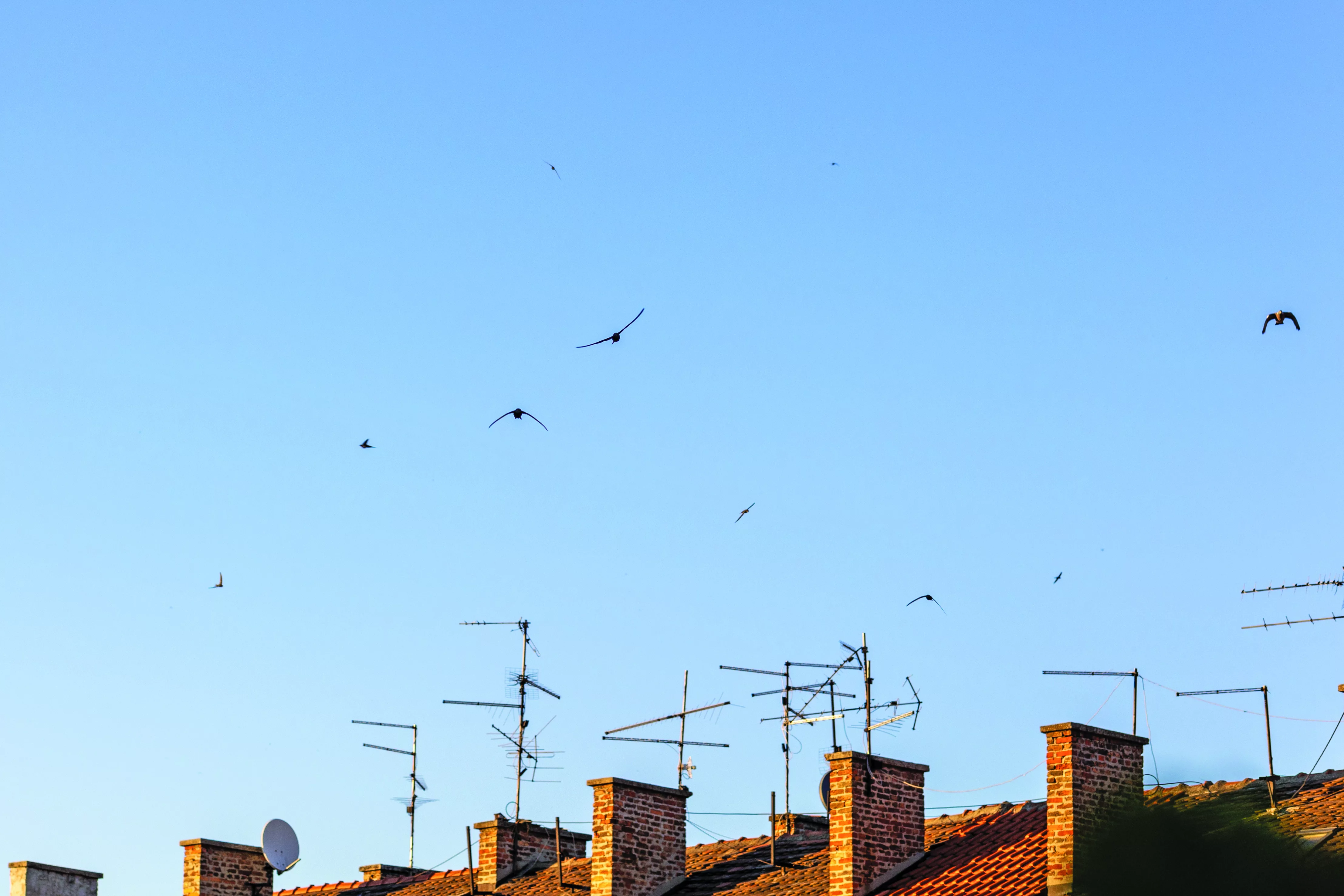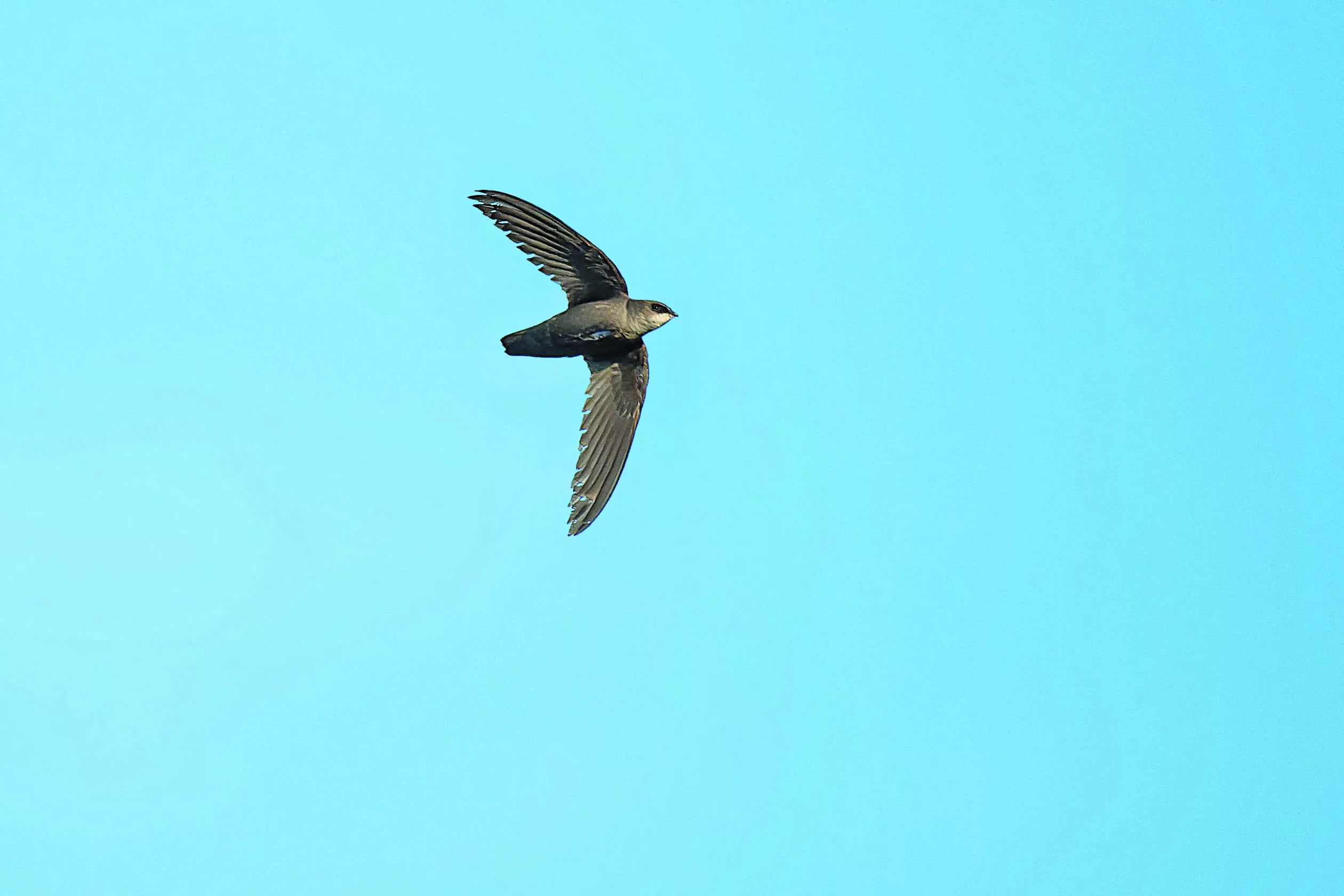
By Jim Knox
The peal of their clear twittering calls drifted down to me as I watched the small birds zip and wheel against a deepening summer sky high above town hall. While I couldn’t make out their quarry, I could tell they were on the hunt, banking and swooping to snatch their prey in midflight. Never seeming to relent, their swirling hunting flight in the sky above pulsed with energy.
The Chimney swift, Chaetura pelagica, is a wonder of the natural world. At first glance inconspicuous, the small ashy gray bird lacks the pomp of the peacocks or the palette of the parrots, but a closer look reveals a creature of engineering beauty. At 4.5 to 6 inches in length, with an 11–12-inch wingspan, the swift is small, and with a body mass of a mere ounce, it is an ultra-light wisp on a wing. Equipped with long, crescent-shaped wings twice the length of its bullet-like body—it slices the air. This unique design confers the aerodynamic edge needed to evade nearly all predators and lock in on its highly maneuverable prey. Built for an unbeatable combination of speed—more than 60 miles per hour in level flight—and the ability to outmaneuver their tiny speedy prey, swifts are seemingly always one step ahead of predator and prey alike. With their unpredictable darting flight paths, these tiny creatures can evade all but certain raptors such as the ultra-swift Mississippi kite, and the 225 mile per hour Peregrine falcon!

Favoring wasps, bees, flies, mosquitos, ants, and airborne spiders floating on silk strands, these insectivores employ a suite of adaptations to successfully target their airborne prey. Visual hunters, swifts possess recessed independently focusing eyes protected by bristle-like feathers, enabling them to fly deep within swarms of insects and select individual prey while still avoiding collisions with other swifts. Similarly, possessing a tiny aerodynamic beak, the bird’s mouth is cavernous, extending past its eye. This provides the bird with a huge gape to engulf prey on the wing—up to an astonishing 12,000 insects each day!
Ranging throughout the Eastern United States and Southeastern Canada, and wintering in Northern South America, the Chimney swift likely expanded its population with New World colonization. Originally, cliff, cave, and tree nesters, Chimney swifts adapted to nesting in chimneys, barns, cupolas, churches, lighthouses, outhouses, sheds, silos, wells, cisterns, boat houses, and other structures. In fact, they are one of the few bird species equally adapted to urban, suburban, and rural habitats. Possessing tiny sharpy-clawed feet, swifts are incapable of upright perching and must perch on vertical or near vertical surfaces. Hyper adapted to a life of flight, and perching only to roost or nest, they are the aerial specialists in the world of aerialists. Their refined anatomical design provides swifts with the ability to remain aloft for extended periods. In fact, Chimney swifts are so adapted for airborne life, they drink and bathe on the wing, drinking by skimming their tiny beaks over the surface of ponds, lakes and rivers, and bathing by splashing water on their breasts to shake over their bodies.
Yet, as superbly adapted as Chimney swifts are, they struggle with the often-accelerated changes to our planet. With populations declining throughout their range since the 1960’s, the federally protected Chimney swift has been accorded Near Threatened species status with rapidly declining populations by the International Union for Conservation of Nature (IUCN). The reasons for these declines are not well understood. Preliminary research indicates pesticide usage has led to a decline of many insect prey species, while climate change, habitat alteration, and chimney capping have affected populations significantly. Though not colonial nesters, they often roost in large aggregations of between 100-1,000 birds, leaving them susceptible to disturbance or alteration of just a single roosting site.
Highly beneficial and possessing seemingly ethereal flight ability, Chimney swifts are marvels of the natural world. Their mosquito munching ways are among our best defenses against the spread of mosquito-borne zoonotic diseases. So, what can we do to protect Mother Nature’s turbo-charged bug zappers? The National Audubon Society, Cornell Lab of Ornithology, and The Connecticut Department of Energy and Environmental Protection all have excellent resources for conservation measures we can take on our properties, and in our communities, to protect these amazing creatures.
Seeming to defy the limits of endurance, and the laws of flight, and roaming the vast expanse of the sky, the Chimney swift is unlike other creatures. Observance of these tiny birds redefines what is truly attainable. By pushing beyond what others consider possible, to evading forces that threaten to bring us down, to employing innovation that untethers us from the competition, the Chimney swift offers us a skyward model for performance. While life invariably presents us with challenges both great and arduous, with boundless energy and an unconstrained spirit, nothing is beyond those who are swift of heart
.Jim Knox serves as the Curator of Education for Connecticut’s Beardsley Zoo and as a Science Adviser for The Bruce Museum. His passions include studying our planet’s rarest creatures and sharing his work with others who love the natural world.

